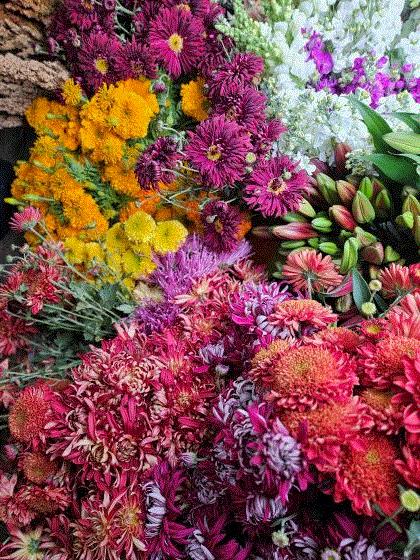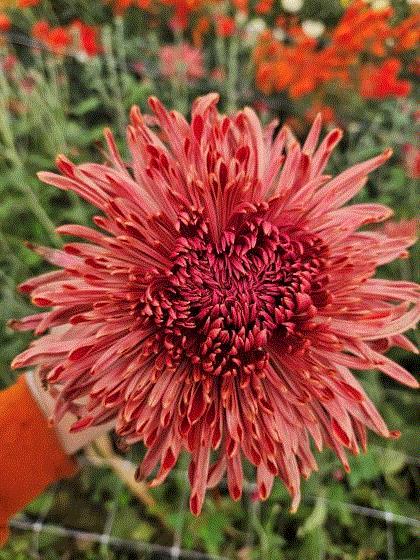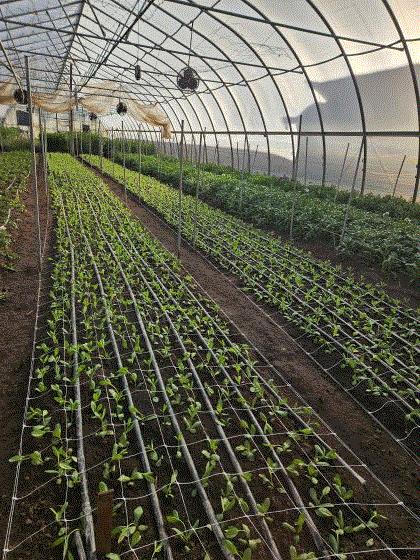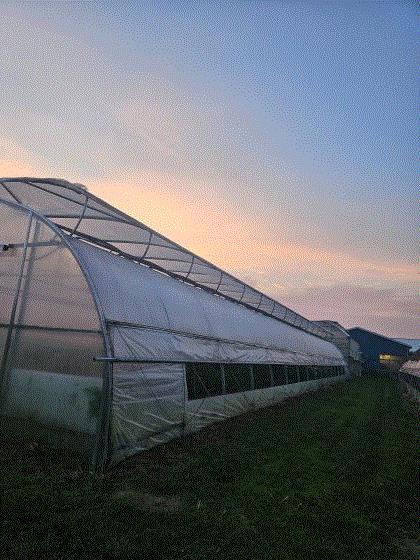November Farm Update

Heirloom chrysanthemums, lilies, marigolds and stock from our farm this week.
Tater and I are swimming in heirloom chrysanthemums, stock, snapdragons and foliages! Foliage is an unsung hero for cut flower farmers—don’t underestimate its importance. The eucalyptus and dusty miller made a tremendous rebound and are rounding out our crop offerings for November.
I am also grateful we took the time in July and August to plant marigolds, snaps and stock in the greenhouses. It’s challenging to shift gears for fall planting in the middle of peak summertime dahlia and sunflower season. But we did, and as a result, we still have a well-rounded offerings to give our florists.
Over the years I have learned it is tough when you have just one crop to sell. Heirloom chrysanthemums may be the highlight, but the supporting cast of lilies, stock and snaps keep our customers engaged. The more seasons we farm, the more I tweak our sowing schedules to maximize our offerings for November. I personally see a lot of potential in November sales, since the crops get the advantage of bright sunny days in August before the cloudy season of October and November. It’s worth thinking about, especially if you have indoor covered space. The longer your customers can depend on you in a season, the more likely they are to be conditioned to buy from you next spring when you have flowers again.
Team Forget Me Not managed to clean up the field, removing all the field plastic and drip tapes before our first snow of the season last weekend. This year it feels like summer and winter are compressed together, with just a sprinkle of fall in between the extreme temperature swings. It's been so warm lately, we even delayed our sweet pea sowings from October to November! But farming is all about rolling with the punches, and I bet the sweet pea are relieved that we didn’t subject them to multiple days of 80F temperatures we had last month.
Now we are in the process of putting the farm to bed and prepping the greenhouses for the winter heating season. In this edition of Bloom Beat, we are talking about enterprise budgets, chrysanthemums, ikebana and more.
With all that being said, let’s talk shop!

New Budget Planning Tools From the University of Tennessee
One of my favorite quotes of all time is credited to Benjamin Franklin: “People don’t plan to fail. They fail to plan.”
As you start to downshift for the year, it’s a great time to take stock in the seasons and dive into your production data. It’s easy to pour over seed catalogs and dream about every color zinnia imaginable, but at the end of the day it comes down to what flowers makes your farm a profit. No one starts farming because they love spreadsheets—but I have great news! The folks at the University of Tennessee have created new enterprise tracking templates for celosia, cosmos, gomphrena, sunflowers and zinnias. These are very handy tools to help you craft your production plan for 2026.
According to
UT Extension specialist Rachel Painter, one of the authors of this project, “Our goal in developing these budgets is to provide Tennessee famers with practical, research based tools to plan and make informed business decisions. [Enterprise budgets] provide a clear view of the financial considerations in cut flower production and help producers elevate profitability before planting a seed.”
One of the best parts about these spreadsheets is that you can customize them with your own farm data. Tater and I really encourage you to do this. Even if you have a ballpark estimate, that’s better than using someone else’s generic data. A very wise professor and mentor once told me, “What gets measured gets managed.” As you plan for 2026, keep your profitability in mind.
You can find the templates
HERE.

Ikebana and Heirloom Chrysanthemums

Ikebana arrangement by our friends at Hafner Florist.
We are in the last two weeks of heirloom chrysanthemum season here. Fancy mums like these can be tricky for florist sales, because our mums are substantially more expensive than the ones they can purchase from the wholesaler. It’s taken a few years, but our clients are starting to understand why our mums are a premium product.
One of our best clients took a personal liking to our heirloom mums and uses them in his ikebana arrangements. His social media posts and creative interpretation of seasonality and minimalism using our chrysanthemums inspired our other clients to incorporate them into their arrangements as well. I call this-organic marketing at its finest.
To see some of his work, check his
INSTAGRAM.
Seasonality is one of the backbone principals of ikebana. Disbudded heirloom chrysanthemums make great specimen flowers.
 One of our disbud chrysanthemums, Seaton's Coffee
One of our disbud chrysanthemums, Seaton's Coffee
His work inspired me to take a deep dive into the art of ikebana and learn why chrysanthemums are a great fit for this art.
Chrysanthemums, also known as “kiku” in Japanese, have deep roots in Japan. The Japanese royal family adopted the 32-petal chrysanthemum design for the imperial crest in 1336. In Japanese culture chrysanthemums represent longevity, rejuvenation and the royal family. The origins of ikebana trace back to the Heian period (794-1185) as offerings at Buddhist altars to honor the souls of the dead. Over time, ikebana evolved into not just a religious ceremony but an artistic interpretation of human harmony with nature, seasonality, simplicity and negative space. The seven basic
principles of ikebana are as follows:
- Minimalism: Use only essential elements, simplicity is key.
- Shapes and Lines: Lines and shapes guide the viewer’s eyes in the arrangement.
- Form: The overall shape of the arrangement reflects the artists feelings.
- Structure: Ikebana uses a triangular framework. There are three points in the arrangement representing heaven, earth and humanity.
- Humanity: It’s a form of human expression. The artist's feelings should be conveyed in the work.
- Aesthetics: Simplicity is paramount, but each bloom has its own complexity and refined uniqueness.
- Silence: Emphasizes a meditative approach to practicing the art; the focus should be on nature.
There are many different styles of ikebana that have evolved over the years—some are more casual, others are more formal. For more information, check out this
BLOG by The Floral Society to learn more about each style and the mechanics behind them.
For all you chrysanthemum lovers and ikebana enthusiasts out there, add the
Kasama Chrysanthemum Festival to your bucket list. The festival began in 1908 at the Inari Shrine in Kasama, Japan, to celebrate chrysanthemums and their role in Japanese culture. There are hundreds of chrysanthemum displays in the form of sculptures, bonsais, ikebana arrangements and more. The 2026 dates for the festival have yet to be released, but the festival lasts several weeks, usually starting in late October and running through late November. For more information check out the festival
WEBSITE. You can also check out some photos from this year’s festival
HERE.

High Tunnel Winterizing Tips and Tricks

Tater and I are working hard this week to winterize the greenhouses for the season.
When it comes to high tunnel repair and maintenance, the best offense is a good defense. Winter growing is expensive, so it is important to make sure the structures are sound before we plant all of our favorite spring flowers in them. Equipment and structural failure are a sure-fire way to reduce your profit and break your heart. As they say, an ounce of prevention is worth a pound of cure, so Tater and I are going to walk you through our high tunnel and greenhouse check list for the fall. We hope this helps your winter growing season get off to a strong start.
We try to inspect our greenhouses and high tunnels after each crop cycle. We are nowhere perfect at this, but it’s a goal we shoot for. This week, I am inspecting all of our tunnels for tears and installing wiggle wire on the side vents to prevent heat loss. Not only does sealing up your side vents preserve heat, it also prevents wear and tear on the plastic for your side vent.
You should also inspect any roll-up side vents for frayed retaining ropes and loose eye bolts. If I find tears over a half inch long I use greenhouse patching tape to cover them. It doesn’t take very many tears to prevent your greenhouse from inflating properly. This task can be tedious but it’s very important in preserving the integrity of your plastic. Patching is a pretty simple, all you need to do is use a rag and soapy water to clean the area around the tear, dry it off, and apply your greenhouse plastic repair tape. For those of you new to this, this
ARTICLE from bootstrap farmer will walk you through it.
Also, if you use liquid shading during the summer, now is a great time to remove it.
For our greenhouses with powered gutter vents, we lubricate the vent motors and inspect the rack and pinions. We use a wire brush to clean the grime off of the pinions. This can be very time consuming depending on the length of the vent. But it is worth taking the time, because there is nothing worse than opening your top vent on a sunny winter day and not being able to close it later in the evening when temperatures are below freezing. So save yourself the panic and clean the pinions! Once the pinions are clean, lubricate the pinons and the vent motor. Check out this
VIDEO from Wadsworth Controls to walk you through this if this is a first for you.
 Vent maintenance is an important step in making sure your winter growing season is off to a great start.
Vent maintenance is an important step in making sure your winter growing season is off to a great start.
Tater and I also check that the vents are closing tightly. If the vent isn’t closing tightly, and there are visible gaps, you will need to adjust the limit switches in the vent motor—that can be somewhat technical. Which is why it is important to check your vents before the heating season and reach out to your greenhouse maintenance company of choice if you need support.
You should also check the doors on your greenhouse for soil buildup at the bottoms. This can cause ice accumulation and make it difficult to open the doors during the winter. Install brushes or flexible plastic flaps underneath your doors to prevent this. The good news is that these last for many years once they are installed.
In Michigan, we must heat our greenhouses to have a spring crop. Natural gas is our second-highest direct cost of production, second only to labor. Needless to say, we try to prevent as much heat loss as possible. One of the first steps we take is checking the thermostats for each heater and making sure they are reading correctly. I had one thermostat that read 10F higher than the ambient temperature this fall. Luckily, we caught it and installed a new one. But I like to test the heaters and the thermostats on the first cool evening of the season. Don’t wait until it is freezing before you do this. I let the heaters cycle twice to make sure they are working. If your heater is not turning on even though the thermostat “clicks” you may need to check the wiring connecting the thermostat to the heater. It’s common—at least on our farm—for the thermostat wires to sun rot during the summer. It’s as simple as restriping the wires and reconnecting them to the heater. Make sure you turn the electrical breaker off when you are doing this. The good news is that this is an easy fix!
Heaters need to be checked as well. Make sure the nozzles are free of cobwebs and debris. If you have an older heater you will need to make sure the pilot is clean. If you see a lot of carbon build up on your heaters, it's time for additional maintenance and an immediate inspection. When this happens, I call in an expert—again, the reason it's important to check your heaters before you enter heating season. It gives you time to address the problem and call in reinforcements if needed.
Here is a
LIST from the University of Florida highlighting additional important heater maintenance (yes, it gets cold in Florida, too!).
Last but not least, check your horizontal air flow (HAF) fans and roof inflator fans. Make sure they are free from debris. Rinse off or use forced air to clean the blades. Lubricate the motor if needed. For more information on inflator fan maintenance and installation, check out this e-Gro
ALERT from my dear friend Dr. Garrett Owen at Ohio State University.


We're Cheering for You!
Lindsay Daschner (and Tater)
Editor-at-Large—Bloom Beat
Owner—Forget-Me-Not Farms
This email was received by 6,244 of your fellow fresh-cut flower growers!
If you're interested in advertising in Bloom Beat, contact Kim Brown and she will hook you up!